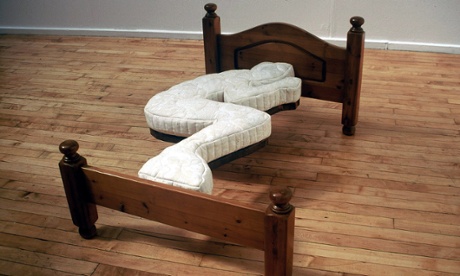
When Dominic Wilcox left art college, he had a notebook full of sketches – inventions, as he calls them. Most served their full purpose as drawings – they are, he says, “little comments about everyday life” – but he selected six of the ideas to turn into physical objects, among them a bed shaped like a single reclining human (he used his own body as a template for the mattress).
The physical object, he realised, brought about a very different reaction in the viewer. Where the drawing was whimsical, the object was distinctly surreal. “When it’s there in front of you, it pushes the absurdity to the limit,” says Wilcox. If you see a teacup with an incorporated cooling fan sketched on the page, you’re inclined to smile. When you see such a thing in real life – with the cup’s blue Wedgwood pattern mirrored in the attached fan – it is a little bit unsettling. “People are never completely sure whether I’m serious or joking,” says Wilcox. “I quite enjoy that.”
In 2009, Wilcox, who was born in Sunderland and is now based in London, started a blog to showcase his notebook drawings – a collection of ordinary objects repurposed, rethought and reinvented. He has just published a book of the blog called Variations on Normal. The drawings have a real immediacy: you get the idea straight away. “It’s the shortest distance between my imagination and the reader’s imagination,” he says. “I don’t really get the need to actually make them.”
When Wilcox does get the urge to give his inventions physical form, it is often the start of a long learning process: investigating methods of manufacture, acquiring new skills or persuading experts to help. The objects aren’t mere 3D representations; they have to do what they’re supposed to do. “I start a lot of projects without being totally sure where they’re going to end up,” says Wilcox. “But then I will travel a million miles until that thing is made.”
The impact of each object is just as unpredictable. Some of them you’re content to look at. Others you want to try. A few you want to own.
Plant pot umbrella
This device – designed to water your plants while you’re out in the rain – was constructed as part of a Selfridges window display. It was, says Wilcox, more of a sketch brought to life than a standalone object, a simple idea enabling a busy person to do two things at once. “I walked round Hackney with it and no one batted an eyelid,” he says.
Xylophone bin
Wilcox was asked to customise an ordinary pedal bin for a charity auction in New York. “The only interesting thing about it was that the lid lifted up when you stepped on the pedal,” says Wilcox, “but there’s a little bit of magic in that.” He decided to enhance the mechanical magic: each time the lid opens, a ball-bearing is released, producing a descending scale as it travels down a circular staircase made from xylophone bars. “It’s highly delicate,” he says. “The packaging to ship it to New York was even more complex.”
Reverse hearing device
Wilcox made a drawing of a double ear trumpet that allows the wearer’s left ear to hear what the right one normally hears, and vice versa. He ended up making the prototype, he says, “because I actually wanted to hear what it would be like. And it works.” The effect is surprisingly disorientating, with sounds coming in from the wrong direction, although Wilcox thinks that if you wore the device all the time your brain would eventually adjust. “I should charge people to have a go.”
GPS shoes
These shoes have directional LED lights embedded in the toes – activated by clicking the heels – to lead the wearer home. Wilcox had to have help with the GPS technology, but he was clear from the beginning that the shoes should be traditional brogues. “Wearable technology is quite big,” he says. “But I thought, ‘Let’s make them a nice pair of shoes, with the technology subtly incorporated, not gadgety.’”
Finger nose stylus
Wilcox sometimes uses his phone in the bath, but found he couldn’t work the touch screen with a wet finger. His nose worked, but then he couldn’t see what he was doing. What was needed was some kind of extension. The resulting finger nose stylus was what Wilcox calls a “sketched object”: he made it himself, out of modelling material and a strap, in a day, then put a photograph up on his website. “They showed it on Have I Got News for You,” he says. “They were ridiculing it.”
Pre-handshake handshake device
“It’s for people who have really fallen out,” says Wilcox. When warring relatives or protocol-wary diplomats feel that a handshake is too big a first step, this device provides “a little start toward reconciliation” – a non-contact handshake of lesser significance. “I want to sell it as a product, not an artwork,” says Wilcox, who envisages his invention being used in embassies and family counselling offices. “I think this device could genuinely save the world.”
• Variations on Normal by Dominic Wilcox is published by Square Peg (£10). Buy a copy for £8 including free p&p at theguardian.com/bookshop.
.

